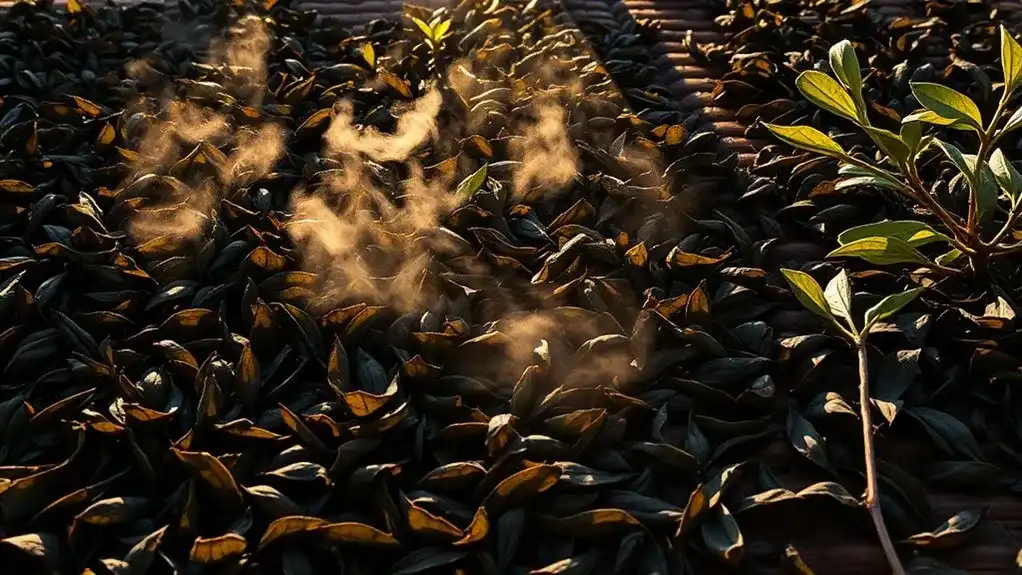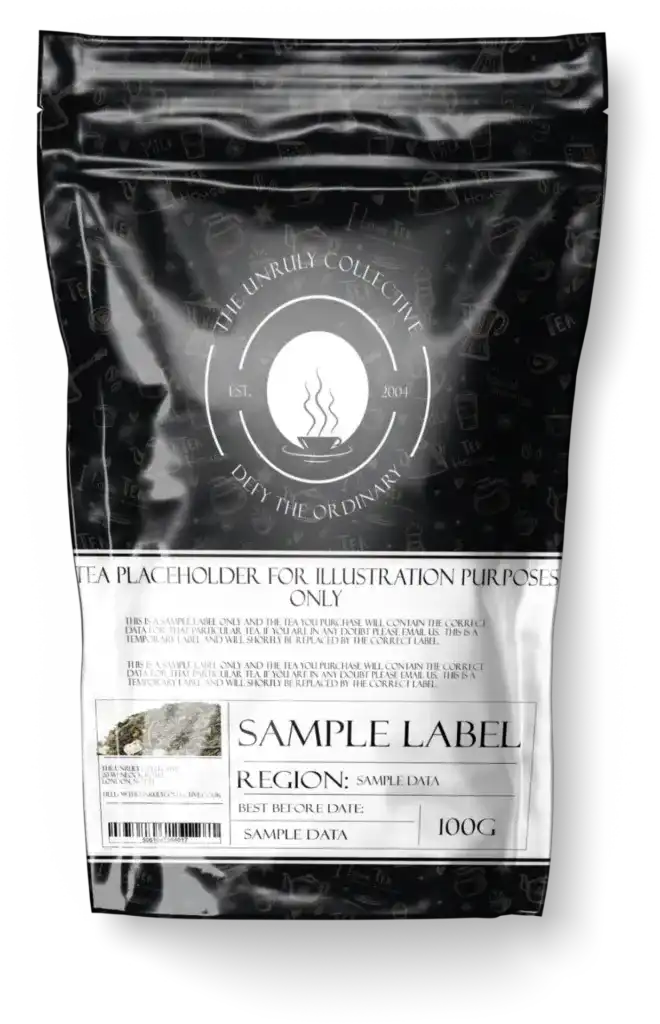Tea leaf drying requires precise control of temperature, time, and technique to achieve ideal quality. The process starts with leaves at 58-62% moisture content during withering and ends at 2-3% for shelf stability. Traditional methods like sun-drying can take days, while modern commercial dryers operate at 120-150°C for faster results. Proper drying prevents bitterness, mold, and damage, ensuring the perfect cup. Understanding these elements reveals the artistry behind tea's journey from field to cup.
Key Points
- Optimal drying temperatures range from 120-150°C, with specific requirements varying by tea type (green tea: 110-120°C, black tea: higher).
- Moisture content should decrease from 58-62% during withering to 2-3% after drying for optimal shelf stability.
- The ideal moisture loss rate during drying is 2.8-3.6% per minute to prevent bitter flavors and leaf stewing.
- Traditional methods include sun-drying and charcoal firing, while modern facilities use automated conveyor systems and fluidized bed technology.
- Good air circulation prevents uneven drying and mold formation, making proper ventilation essential throughout the drying process.
The Science Behind Tea Leaf Moisture Content
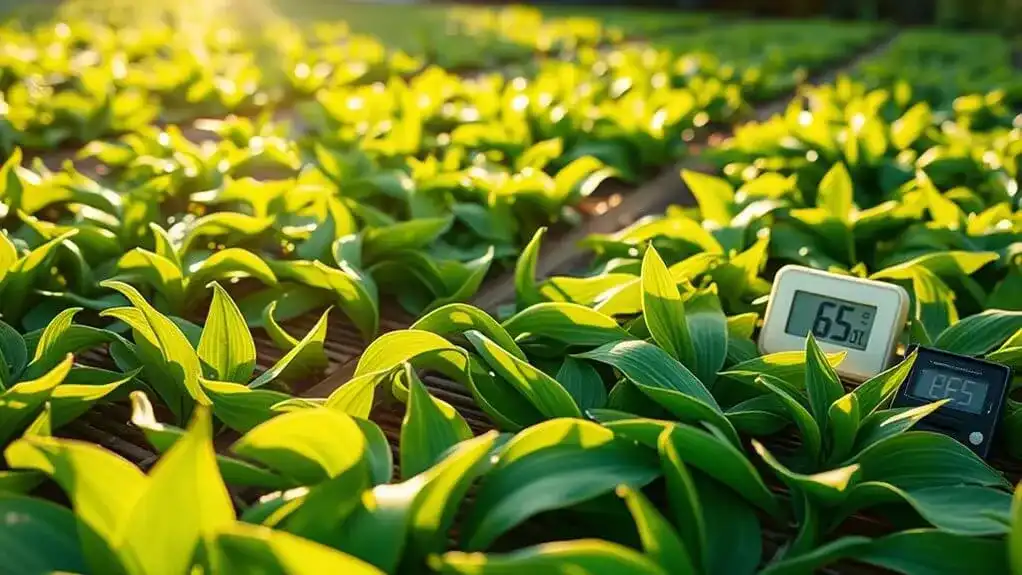
While tea processing involves many critical factors, moisture content stands as one of the most essential elements affecting quality and shelf life. Tea leaves must maintain precise moisture levels throughout production, from 58-62% during withering to a final 2-3% after drying, to prevent bacterial growth and preserve flavor compounds. Traditional producers often rely on hot air drying methods with specialized conveyor systems for optimal results.
Modern moisture measurement techniques have revolutionized this process. Advanced sensor technology, including hyperspectral imaging and VIS-NIR spectroscopy, enables producers to monitor moisture levels without damaging the leaves. These non-destructive methods operate in the 500-870nm spectral range, providing real-time data for ideal drying conditions. Machine learning models, particularly random forest algorithms, enhance accuracy by analyzing factors like leaf thickness and bulk density. Recent studies achieved prediction accuracies of 0.8977 using partial least squares regression with optimized data processing. Transfer learning models using just 55 training samples have demonstrated remarkable success in moisture prediction. This scientific approach guarantees consistent quality while preventing common issues like stewing from slow drying or case hardening from rapid drying.
Traditional Drying Methods Across Tea Cultures

Throughout history, diverse tea cultures have developed unique drying methods that reflect their climates, traditions, and desired flavor profiles. These cultural variations range from sun-drying in high-altitude regions to sophisticated shade-drying techniques that protect delicate leaves. Some cultures embrace pan-firing, while others rely on air-drying in well-ventilated spaces. Moisture reduction is essential for preserving tea quality. Early spring harvests yield the most delicate and nuanced flavors for premium teas.
Drying innovations have evolved to include specialized methods like charcoal firing in bamboo baskets and heating on traditional masonry floors. The orthodox method, widely adopted across regions, combines withering, rolling, oxidizing, and final drying to achieve specific tea characteristics. Each approach serves a distinct purpose: sun-drying offers gentle processing, while roasting adds toasted notes. In oolong production, leaves undergo shaking in baskets to create the desired level of oxidation. These methods aren't just practical solutions – they're integral parts of tea-making heritage, with each culture contributing unique techniques to the global art of tea production.
Modern Commercial Drying Technologies

Modern commercial tea drying has transformed dramatically with the advent of sophisticated technologies. Today's facilities employ a range of modern innovations, from endless chain dryers with perforated conveyors to fluidized bed systems that use hot air for peak drying efficiency. Microwave and infrared technologies have revolutionized the process by reducing drying times while preserving tea quality. The precise control allows processors to maintain 2-3% moisture content for optimal shelf stability. While purists debate quality, these modern methods have become necessary to meet the growing global demand for matcha and other teas.
These advanced systems incorporate multi-stage drying and controlled environments, allowing precise regulation of temperature and humidity. Pulsed air flow and hopping actions guarantee uniform results, preventing common issues like case hardening. The benefits extend beyond improved product quality – automated systems reduce labor requirements, increase production capacity, and often prove more energy-efficient. For commercial producers, these technologies deliver consistent results while minimizing waste and environmental impact, making them increasingly valuable in modern tea processing.
Temperature Control and Quality Impact
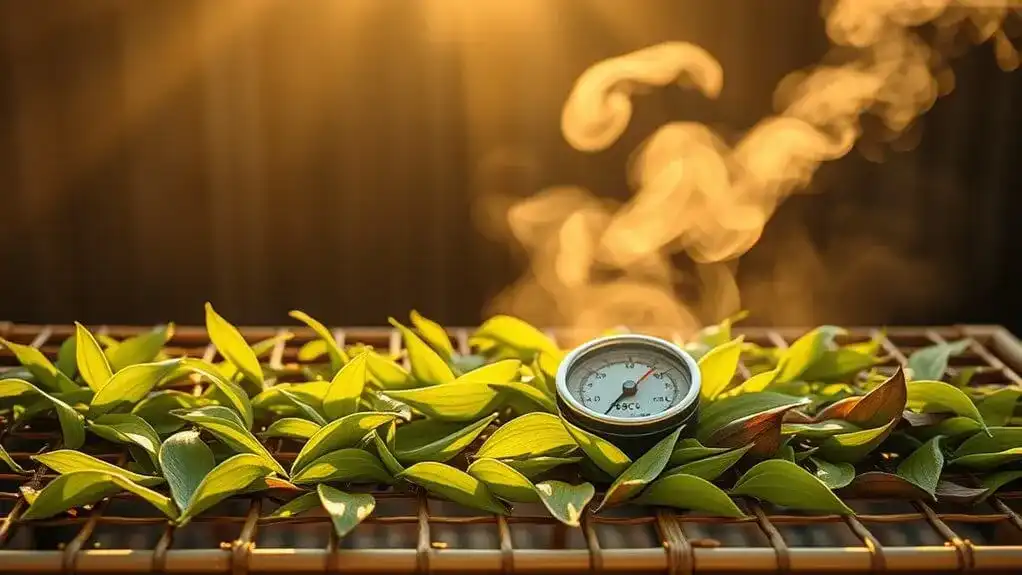
Precise temperature control stands at the heart of successful tea leaf drying, with ideal ranges typically falling between 120-150°C. Temperature consistency during the initial drying stage is essential, requiring careful adjustment of cold air doors and liquid-gas valves to maintain ideal conditions. This precision directly impacts flavor enhancement and final product quality. A continuous mesh belt system enables efficient large-scale processing while maintaining temperature control precision. Skilled artisans must carefully monitor the process as expert craftsmanship ultimately determines the tea's final characteristics. Recent studies show that drying at 118°C optimal temperature can significantly reduce energy consumption while maintaining tea quality.
Different tea varieties demand specific drying approaches. Green tea requires lower temperatures around 110-120°C to preserve its natural characteristics, while black tea undergoes controlled oxidation at higher temperatures for robust flavors. Quality assurance measures include pre-heating ovens to 130°C and maintaining proper leaf thickness of 1.5cm. The process typically spans 30-40 minutes for the first pass, with subsequent drying phases at adjusted temperatures. Continuous monitoring guarantees the desired moisture content and flavor profiles are achieved.
Time Management in Different Drying Processes
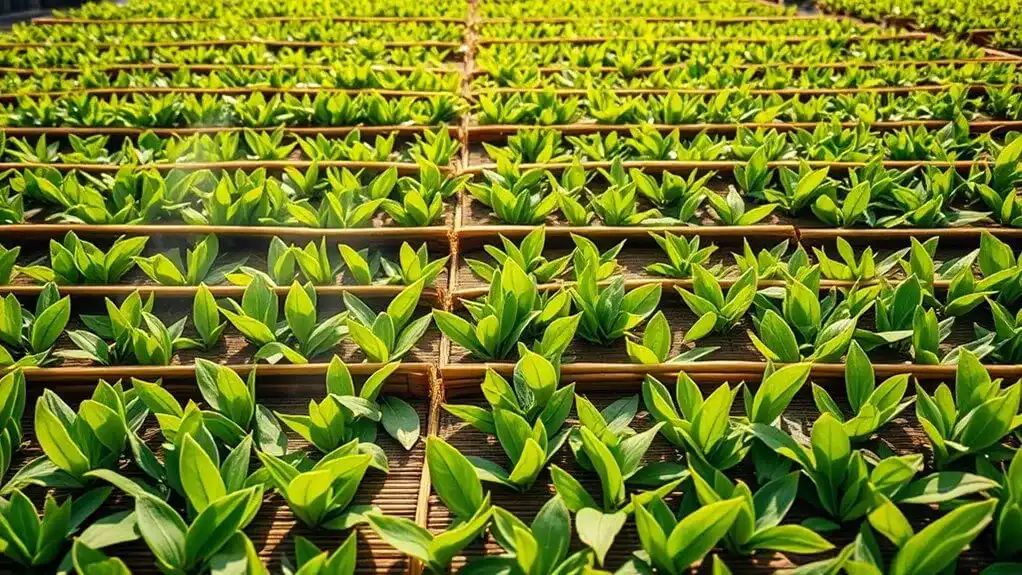
Successful tea drying hinges on carefully managing process duration across various drying methods. The key to ideal drying efficiency lies in maintaining moisture loss at 2.8-3.6% per minute, as faster rates can produce bitter, harsh flavors, while slower rates risk stewing the leaves. Adding carboxymethyl cellulose with a degree of substitution 0.5 helps optimize moisture retention during processing. Once dried, tea leaves should be discarded within three hours after steeping to prevent bacterial growth.
Different techniques offer varying timelines for achieving perfect moisture retention. Commercial dryers and fluidized bed systems provide rapid processing, while traditional methods like sun drying can take 3-5 days. Dehydrators offer a middle ground, completing the process in about 28 hours with controlled settings. Using a Gardenmaster by Nesco dehydrator provides consistent results with expandable capacity up to 20 trays. The chosen method must align with the tea type's specific needs – green tea requires quick drying to halt oxidation, while pu-erh undergoes a longer process to develop its complex profile. Regardless of method, leaves must reach 2-3% moisture content for proper shelf stability.
Preventing Common Drying Mistakes
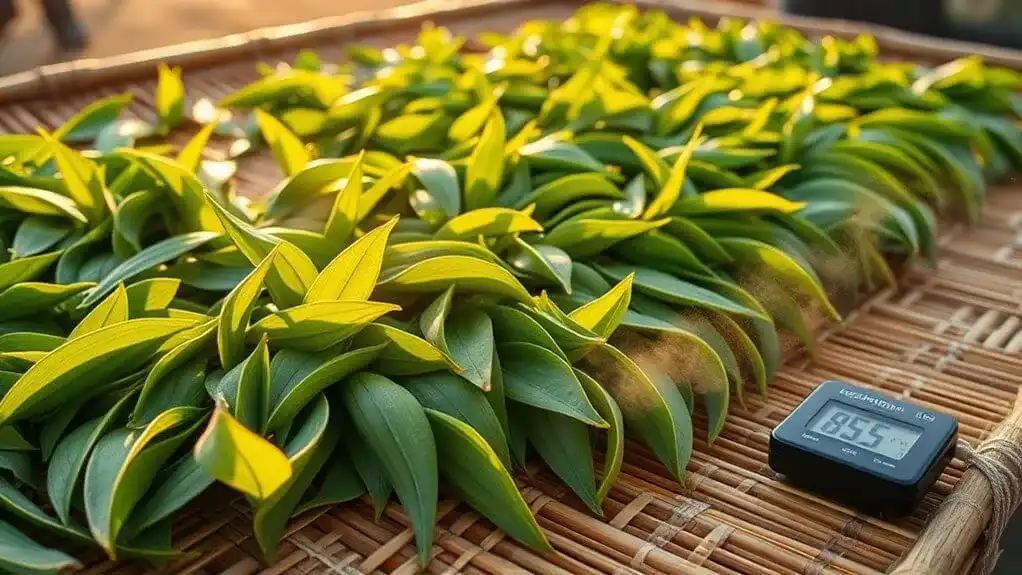
While tea leaf drying may seem straightforward, avoiding common mistakes requires careful attention to several essential factors. Tea producers must maintain consistent moisture monitoring throughout the process, as excessive moisture can cause leaves to break during rolling, while insufficient moisture from rushed withering leads to similar problems. Applying the correct rolling pressure is equally vital – too much force with high moisture content results in wet, foamy leaves. Sun drying methods require extra vigilance since weather conditions can significantly impact results. To prevent these issues, processors should gradually increase rolling pressure and guarantee proper withering time. Good air circulation prevents uneven drying and mold formation, while using screens or dehydrators helps maintain uniform drying conditions. The drying rate should stay between 2.8-3.6% moisture loss per minute, as faster rates create bitter, harsh flavors and slower rates lead to stewing. For black tea production, leaves should change from green to copper brown color during the rolling and oxidation phases.
Optimal Storage After Drying

Proper storage of dried tea leaves plays an essential role in maintaining their quality and flavor profile over time. The key to success lies in selecting appropriate storage containers and implementing effective humidity control measures.
Tea leaves thrive in environments between 10°-25°C, away from direct light and strong odors. Airtight containers made from tin, dark glass, or ceramic offer the best protection, while plastic and paper bags should be avoided. For ideal preservation, it's important to minimize air exposure by using vacuum-sealed containers or mylar bags with oxygen absorbers. Oxygen absorbers can be added to protect against degradation of tea components. Lighter oxidized teas are especially vulnerable to aging effects and require particularly careful storage. Using acid-free paper as container lining helps prevent tea degradation while managing moisture levels.
Proper humidity control starts with choosing a cool, dry storage location away from heat sources. While the refrigerator might seem like a good option, it can introduce unwanted moisture. Instead, focus on maintaining consistent temperature and humidity levels in a dedicated storage space.
Conclusion
Mastering tea leaf drying isn't just a process – it's an absolute art form that'll make or break your cup of paradise. From scorching hot woks in China's mountains to state-of-the-art dehydrators humming in modern factories, every second and degree matters monumentally. When done right, properly dried leaves won't just survive, they'll dance with flavor for years, transforming simple water into liquid gold with each steeping.
